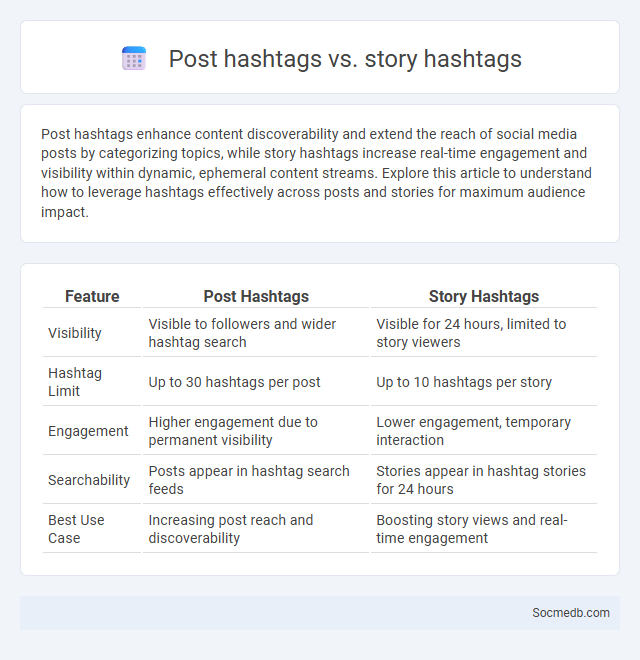
Photo illustration: Post Hashtags vs Story Hashtags
Post hashtags enhance content discoverability and extend the reach of social media posts by categorizing topics, while story hashtags increase real-time engagement and visibility within dynamic, ephemeral content streams. Explore this article to understand how to leverage hashtags effectively across posts and stories for maximum audience impact.
Table of Comparison
| Feature | Post Hashtags | Story Hashtags |
|---|---|---|
| Visibility | Visible to followers and wider hashtag search | Visible for 24 hours, limited to story viewers |
| Hashtag Limit | Up to 30 hashtags per post | Up to 10 hashtags per story |
| Engagement | Higher engagement due to permanent visibility | Lower engagement, temporary interaction |
| Searchability | Posts appear in hashtag search feeds | Stories appear in hashtag stories for 24 hours |
| Best Use Case | Increasing post reach and discoverability | Boosting story views and real-time engagement |
Understanding Post Hashtags: Purpose and Best Practices
Post hashtags enhance your social media content's visibility by categorizing posts into searchable topics, making it easier for users to find relevant content. Using a mix of popular, niche, and branded hashtags increases engagement and helps target specific audiences effectively. Ensure your hashtags are relevant, concise, and used consistently to maximize their impact on your social media growth.
How Story Hashtags Differ from Post Hashtags
Story hashtags on social media differ from post hashtags primarily in their visibility and engagement lifespan, as story hashtags appear within temporary content that disappears after 24 hours, while post hashtags remain on a user's profile indefinitely. Story hashtags often attract real-time interaction and can boost immediate discoverability by appearing in hashtag story feeds, whereas post hashtags contribute to long-term searchability and content categorization. These differences influence how users and brands strategically implement hashtags to maximize reach and audience engagement on platforms like Instagram and Facebook.
Visibility and Reach: Post vs Story Hashtags
Post hashtags on social media provide long-term visibility as they remain searchable on profile grids and hashtag pages, maximizing organic reach over time. Story hashtags offer temporary exposure, appearing only for 24 hours but can enhance immediate engagement through features like location tags and interactive stickers. Combining both strategies amplifies overall reach by targeting different user behaviors and discovery methods.
Algorithm Impact: How Hashtags Affect Engagement
Hashtags significantly influence social media algorithms by categorizing content and increasing its discoverability. When you use relevant hashtags, your posts are more likely to appear in targeted searches and trend feeds, driving higher engagement rates through likes, comments, and shares. Optimizing hashtag use aligns your content with algorithmic preferences, maximizing your reach and interaction on platforms like Instagram, Twitter, and TikTok.
Crafting Effective Hashtag Strategies for Posts
Crafting effective hashtag strategies for your social media posts involves researching trending and relevant tags that align with your content and target audience. Analyzing hashtag performance and engagement metrics helps optimize reach and visibility, driving more interaction with your posts. Consistent use of a mix of popular, niche, and branded hashtags ensures your content stands out in crowded feeds and connects with the right users.
Maximizing Story Hashtag Potential
Maximizing story hashtag potential on social media increases your content's visibility and engagement by targeting relevant audiences effectively. Using a mix of popular, niche, and branded hashtags in your stories enhances discoverability and attracts users interested in specific topics or communities. You should analyze hashtag performance regularly to optimize your strategy and ensure your social media stories reach the right viewers.
Common Hashtag Mistakes to Avoid
Using overly generic hashtags like #love or #happy often buries posts in vast content, reducing visibility and engagement. Employing irrelevant or excessive hashtags can confuse the target audience and dilute the brand message, undermining social media effectiveness. Ignoring trending or platform-specific hashtags limits reach and fails to capitalize on current conversations driving user interaction.
Analyzing Hashtag Performance Metrics
Analyzing hashtag performance metrics involves tracking engagement rates, reach, and impressions to determine the effectiveness of your social media campaigns. You can use tools like Instagram Insights, Twitter Analytics, or third-party platforms such as Sprout Social to measure hashtag popularity and audience interaction. Understanding these metrics enables you to optimize your content strategy for increased visibility and targeted reach.
Choosing the Right Hashtags for Your Brand
Choosing the right hashtags for your brand significantly boosts visibility and engagement on social media platforms like Instagram, Twitter, and TikTok. Analyze trending and niche-specific hashtags related to your industry, audience interests, and competitors to ensure your content reaches the right demographic. Utilize tools like Hashtagify or RiteTag to refine your hashtag strategy and maximize your brand's online presence.
Building a Dynamic Hashtag Strategy for Growth
Developing a dynamic hashtag strategy involves researching trending and niche-specific tags to maximize reach and engagement on social media platforms like Instagram, Twitter, and TikTok. Incorporating a mix of popular, moderately competitive, and branded hashtags helps attract diverse audiences and enhance content visibility. Regularly analyzing hashtag performance with tools like Hashtagify or RiteTag enables continuous optimization for sustained audience growth and increased brand awareness.
 socmedb.com
socmedb.com